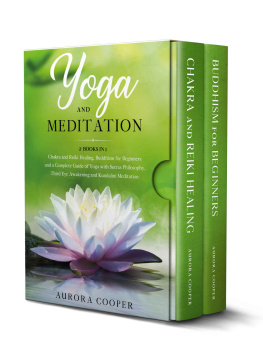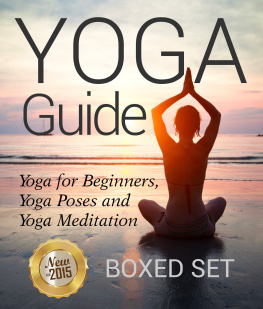YOGA AND MEDITATION
2 BOOKS IN 1: Chakra and Reiki Healing, Buddhism for Beginners and a Complete Guide of Yoga, with Sutras Philosophy, Third Eye Awakening and Kundalini Meditation
AURORA COOPER
Download the Audio Book Version of This Book for FREE
If you love listening to audio books on-the-go, I have great news for you. You can download the audio book version of this book for FREE just by signing up for a FREE 30-day audible trial! See below for more details!

Audible Trial Benefits
As an audible customer, you will receive the below benefits with your 30-day free trial:
- FREE audible book copy of this book
- After the trial, you will get 1 credit each month to use on any audiobook
- Your credits automatically roll over to the next month if you dont use them
- Choose from Audibles 200,000 + titles
- Listen anywhere with the Audible app across multiple devices
- Make easy, no-hassle exchanges of any audiobook you dont love
- Keep your audiobooks forever, even if you cancel your membership
- And much more
Click the links below to get started!
For Audible US
For Audible UK
For Audible FR
For Audible DE
BUDDHISM FOR BEGINNERS
CLEAR AND SIMPLE GUIDE TO INTRODUCE YOU TO THE BUDDHISM AND ZEN TEACHINGS, DISCOVER THE YOGA MEDITATION, THE SUTRAS PHILOSOPHY AND THE SECRET OF DEEP RELAXATION WITH YOGA NIDRA
CHAKRA AND REIKI HEALING
A BEGINNERS GUIDE TO LEARN REIKI MEDITATION, DISCOVER THE POWER OF KUNDALINI AND HEAL YOUR CHAKRAS TO INCREASE POSITIVE ENERGY WITH THE SECRETS OF THIRD EYE AWAKENING
BUDDHISM FOR BEGINNERS
CLEAR AND SIMPLE GUIDE TO INTRODUCE YOU TO THE BUDDHISM AND ZEN TEACHINGS, DISCOVER THE YOGA MEDITATION, THE SUTRAS PHILOSOPHY AND THE SECRET OF DEEP RELAXATION WITH YOGA NIDRA
AURORA COOPER
Copyright 2020
All rights reserved. No part of this publication may be reproduced or distributed in any form or by any means, electronic or mechanical, including photocopying, recording, or by any information storage or retrieval system, without the prior written consent of the author Aurora Cooper.
Contents
Introduction
On December 2007, I embarked on a mission to escape the boring winter and have a break from the shadows of my past. I chose to travel to Thailand just to appreciate and learn more about the kind of rice that I always loved to cook that came from Southeast Asia. Exactly the kind of spontaneous and crazy backpacking trips I love.
One sunny day while I was walking down towards one of the rice fields, I saw a group of five people gathered down by a tree in what was plainly clear to me as monks with the simplest form of being no hair, no shoes, loose robes, no chair or stool. They manifested a gentle mien and serene appearance and seemed unperturbed by the chaotic world around them.
They were very simple, taking on a clean diet of boiled rice and some vegetables, using Thai sticks, which appeared as just a pair of thicker and more elongated toothpicks. No spoons, and still no plates as they were being served food on some kind of roundish basket on which a fitting piece of green banana leaf was spread under the food.
It was such a simplicity and calm that baffled me. It created in me an inner desire to understand how they lived their lives in a way that manifested such a compelling authenticity of peace, harmony and serenity. I started seeking knowledge about their ways of life and started practicing the little things that I learned from them. Well, it did take me some time before I discovered that I was already in the middle of practicing Buddhism.
Buddhism basics
Buddhism refers to the practice of teachings of Buddha. However, for purposes of a fast grasp of Buddhism, lets look at what Buddhism is and what Buddhism is not, in order to set ourselves on the right knowledge pedestal.
What Buddhism is not:
Is not a religion Buddhism shares with major religions one common thing: doctrine. However, unlike others, its not a religion per se. Though still, there are those who have opted to refer to it or practice it as religion. What used to make me fear practicing Buddhism was my wrongly held belief that Buddhism was a weird and bizarre religion that was incompatible with Western ways of living. While in Thailand, under the tutelage of a Buddhist monk, I came to learn how Buddha encouraged his followers not to blindly follow, but arrive at their own truths about his teachings. This made me gain courage to explore more of his wisdom. No religion grants you this freedom to arrive at your own truths about it except Buddhism, which is simply a religion that is non-religious. My increased awareness of Buddhism granted me the first step to pursuing my liberty by not rigidly holding onto any religion in particular, but exploring all religions as much as I could in search of truth without being ensnared by traps of dogmatism. Indeed, I was truly liberated.
Chapter 1.
Core Concept
Paying on this book the whole Buddhist teaching would be impossible. However, it is doable to get familiar inside the basic concept that you'll be able to apply in your health.
Then again, this is not an unexpected transformation. You might even get contrasting some of these concepts, mainly if are derived from a belief that disagrees with all the claims with the Buddhist practice.
A. Life and also the Material World
The notion of Buddhism in life and the material world revolves around the belief in reincarnation. Here, the repetitive cycle of birth, death after which rebirth is named the Samsara. This cycle often happens inside the six plains of existence. Renewal on a certain plain is usually derived from the Karma, or the deeds sowed as seeds by a person within a lifetime. These seeds may do tremendous or bad. Consequences of these seeds could happen within precisely the same life if the seed is sown or upon the following cycle of rebirth. Karma is influenced only through the individual who planted his or her seed. This idea of Karma often results in ignorance from what could be the true enlightenment if anyone is not able to continue with the path to nirvana.
Rebirth then becomes the entire process of successive lifetimes. These lifetimes all start in the moment of conception towards the moment of death. A sentient being can be reborn in any of the six plains (or five plains depending in the branch being followed). These plains are the Naraka, Preta, Animal Plain, Human Plain, Asura, and Deva. Each succession is relying on cause and effect regarding the sowing of the seeds of Karma.
Naraka is the realm comparable to what other beliefs define as hell. It has to be understood though that there can be various forms of Naraka depending on the being that's reborn in this plain.
Preta, on the other hand, maybe the ghost realm. It sometimes shares its existence with the human field thus making the beings within these realms capable of interacting collectively in certain circumstances.
The animal realm shares the same reality in the human field. Still, the beings within these realms are viewed different life forms. This concept could technically be the way to obtain the idea of most Buddhist vegetarians not to eat meat.
The human realm is technically the realm where you are reading this article book as in the moment. Alternatively, in a very sensitive, it could be the realm the location where the author wrote the written text you are reading basing on Buddhist beliefs.
The Asura realm could be the plain for lesser deities for the people beings in a position to reach a specific a higher level of enlightenment. Still, this plain could be home to demons also which may technically be argued capably to reach an enlightened state in their own right.
Next page

















